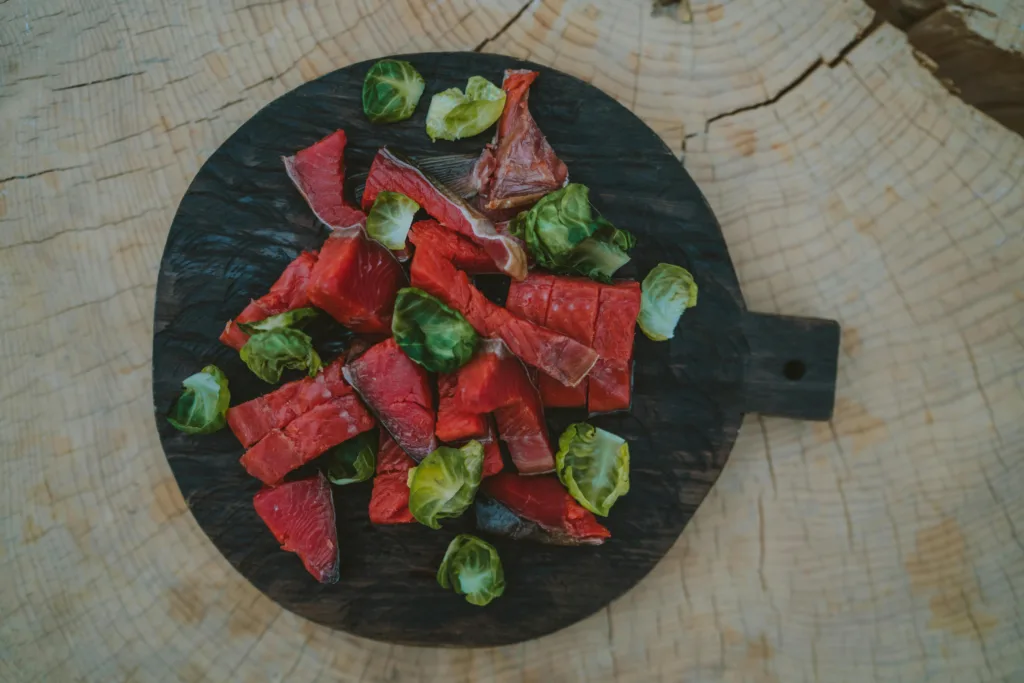As a pet owner, you’re likely curious about the growing trend of feeding your dog raw food, and companies like “We feed Raw” are leading the charge. But before making the switch, you need to know the facts. What exactly is raw food for dogs, and is it safe for your furry friend? Can it be used as a supplement or replacement for traditional dog food, and what precautions should you take? In this review, we’ll investigate into the world of raw food for dogs, comparing “We feed Raw” products to others on the market, and answering the questions you’re asking online.
What is Raw Food for Dogs?
Before stepping into the world of raw dog food, it’s important to understand what raw food is and its implications on your furry friend’s health.
Definition of Raw Food
Fresh from nature, raw food is unprocessed and uncooked, preserving its natural nutrients and enzymes. In the context of dog food, raw food typically consists of meat, bones, fruits, and vegetables that are similar to what your dog’s ancestors would have eaten in the wild.
Benefits of Raw Food
Certainly, a diet rich in raw food can have a profound impact on your dog’s overall well-being. Improved digestion, shinier coats, and increased energy levels are just a few of the benefits you can expect to see in your dog.
What’s more, a raw food diet can also help to reduce allergies and sensitivities, as well as lower the risk of chronic diseases such as arthritis and obesity. By feeding your dog a diet that’s closer to their natural instincts, you’re giving them the best chance to thrive. As you consider making the switch to raw food, it’s important to weigh the pros and cons and understand what to expect.
Types of Raw Food for Dogs
If you’re considering switching your dog to a raw food diet, it’s imperative to understand the different types of raw food options available. You’ll want to choose the best fit for your dog’s needs and lifestyle. The main categories of raw food for dogs include:
| Prey Model Raw Food | Mimics a dog’s natural diet in the wild, with whole prey animals or parts. |
| BARF (Biologically Appropriate Raw Food) Diet | A balanced and varied diet that includes meat, bones, fruits, and vegetables. |
| Recreational Raw Feeding | Adding raw meat or bones to your dog’s existing diet as an occasional treat. |
| Commercial Raw Food Diets | Pre-formulated raw food mixes or patties that meet your dog’s nutritional needs. |
| Homemade Raw Food Diets | Creating your own raw food recipes using fresh ingredients. |
Prey Model Raw Food
On the spectrum of raw food diets, prey model raw food is one of the most natural and simplistic approaches. This type of diet involves feeding your dog whole prey animals or parts, such as chicken necks or beef kidneys, to mimic their natural diet in the wild.
BARF (Biologically Appropriate Raw Food) Diet
Predominantly, a BARF diet focuses on providing your dog with a balanced and varied mix of ingredients, including meat, bones, fruits, and vegetables. This approach aims to replicate the natural diet of wild canines.
Food variety is key in a BARF diet, as it ensures your dog receives all the necessary nutrients. You’ll need to include a mix of muscle meats, organs, and bones, as well as fruits and vegetables. Be cautious when introducing new foods to prevent digestive upset. It’s also imperative to consult with a veterinarian or canine nutritionist to ensure you’re meeting your dog’s nutritional needs. On the positive side, a well-planned BARF diet can lead to improved digestion, shinier coats, and increased energy levels.
Is Raw Food Safe for Dogs?
Any pet owner considering a raw food diet for their dog naturally wonders if it’s safe. With concerns about bacteria, contamination, and nutritional balance, it’s necessary to understand the risks and benefits before making a decision.
Common Concerns about Raw Food
Safe handling and storage are critical when feeding your dog raw food, as bacteria like Salmonella and E. coli can be present in raw meat [making informed choices about sourcing and handling is vital].
Addressing Safety Concerns
Dogs have a shorter digestive tract than humans, which means they’re less susceptible to bacterial contamination, but it’s still necessary to handle raw food safely to minimize risk.
Food safety experts recommend following proper handling and storage guidelines, such as keeping raw meat separate from cooked foods, washing hands thoroughly, and refrigerating or freezing raw meat promptly. By taking these precautions, you can significantly reduce the risk of bacterial contamination. Additionally, choosing a reputable supplier that follows proper food safety protocols can help ensure your dog is getting a safe and healthy meal. On the other hand, improper handling and storage can lead to serious health issues, so it’s crucial to be diligent in your approach.

What are the Raw Dog Food Options?
Here is a comparative of the top 5 Raw dog food options currently available that meet the criteria we discussed earlier. All of them follow a Direct to Consumer model so you may not get them on pet store shelves.
| Company | Product Options | Features | Sales Model |
|---|---|---|---|
| We Feed Raw | 6 raw recipes (chicken, turkey, beef, duck, lamb, venison) | – Customized meal plans – High-pressure processing – USDA-certified human-grade meats – Formulated by PhD animal nutritionist | Direct-to-consumer subscription, one-time bulk orders available |
| Maev | 4 recipes for 3 life stages | – Human-grade, USDA-certified – Frozen bite-sized chunks – Customizable plans – AAFCO-compliant | Subscription with flexible frequency |
| Viva Raw | Multiple options including Emu & Venison, Chicken, Turkey, Beef, Duck, Rabbit | – High-protein recipes – Pure meat options available – Organic fruits and vegetables | Order from Website |
| Open Farm | Multiple freeze-dried raw recipes | – 100% traceable ingredients – Human-grade – No added antibiotics or hormones | Autoship service with 5% discount |
| Raw Wild | Single recipe: organic wild elk and venison blend | – 99% organic wild elk + venison – No hormones, antibiotics, fillers – Made in small batches in the US | Order from Website |
Please note that popular brands like Farmer’s Dog, Noom Noom, Spot and Tango etc. while being excellent fresh dog food options, are not typically categorized as raw dog food brands.
Introducing Raw Food to Your Dog’s Diet
Keep in mind that introducing raw food to your dog’s diet requires patience, caution, and a thorough understanding of the process. It’s necessary to transition your dog gradually to prevent digestive upset and ensure a smooth adaptation.
Supplementing with Raw Food
One of the most popular ways to introduce raw food is by supplementing your dog’s current diet with raw meals or treats. This approach allows you to provide your dog with the benefits of raw nutrition while still maintaining their traditional diet.
Replacing Traditional Dog Food with Raw Food
Some pet owners choose to replace their dog’s traditional food with raw food entirely. [Be aware that this decision should not be taken lightly, and it’s necessary to consult with a veterinarian before making the switch.]
Replacing your dog’s traditional food with raw food requires careful planning and attention to detail. You’ll need to ensure that your dog is receiving a balanced and complete diet, which can be challenging if you’re new to raw feeding. Incorrectly balanced diets can lead to nutritional deficiencies, which can have serious health consequences. On the other hand, a well-planned raw diet can have numerous benefits, including improved digestion, increased energy, and a healthier coat. Make sure you’re prepared to invest time and effort into researching and planning your dog’s raw diet.
FAQ
Q: What is Raw Food for Dogs and How Does it Differ from Traditional Dog Food?
A: Raw food for dogs is an unprocessed and uncooked diet that consists of ingredients such as meat, bones, fruits, and vegetables. It is designed to mimic the natural diet of wild canines, providing vital nutrients and promoting optimal health. Unlike traditional dog food, which is often highly processed and contains fillers, raw food is rich in protein, low in carbohydrates, and free from artificial additives. This dietary approach is based on the idea that dogs thrive on a diet that is closest to their natural ancestral diet.
Q: Is Raw Food Safe for My Dog, and How Do I Introduce It into Their Diet?
A: When handled and prepared properly, raw food can be a safe and healthy option for dogs. However, it’s vital to follow proper food safety guidelines to minimize the risk of bacterial contamination. To introduce raw food into your dog’s diet, start by gradually replacing a small portion of their traditional food with raw food over a period of 7-10 days. Monitor their digestive health, energy levels, and overall condition, and adjust the ratio of raw to traditional food accordingly. It’s also recommended to consult with a veterinarian or a canine nutritionist to ensure a smooth transition, more so if you have a senior dog with health issues.
Q: What’s the Difference Between “We Feed Raw” Products and Other Raw Food Options for Dogs?
A: “We Feed Raw” is a specific brand that offers a range of raw food products for dogs, but as we saw above there are many other options available on the market. When comparing different raw food products, consider factors such as the quality of ingredients, nutritional balance, and manufacturing processes. Look for products that use named protein sources (e.g., chicken or beef), whole fruits and vegetables, and minimal processing. Additionally, check for third-party certifications, such as AAFCO or NASC, which ensure the product meets certain standards for safety and quality. Ultimately, consult with a veterinarian or canine nutritionist to determine the best raw food option for your dog based on their individual needs and health status.
- At Recommended Products Reviewed our goal is to educate you on the latest and trending products and technology that are sustaining and are recommended by experts and others like you. If you care about the environment and want to be made aware of similar trending products, please read our other articles and subscribe to our blog.
- This blog post contains affiliate links. If you purchase through these links, I may earn a commission at no additional cost to you. As an Amazon Associate, I earn from qualifying purchases. This helps support the content and resources I provide. Thank you for your support!


